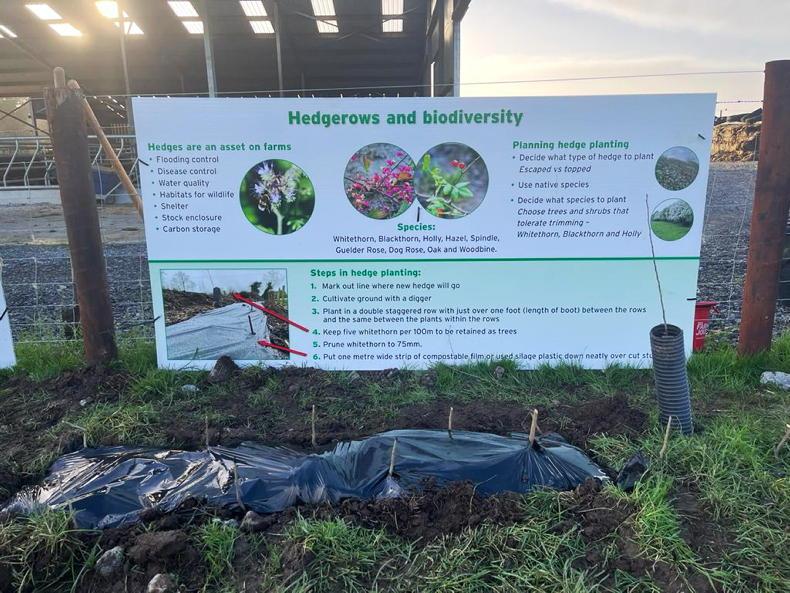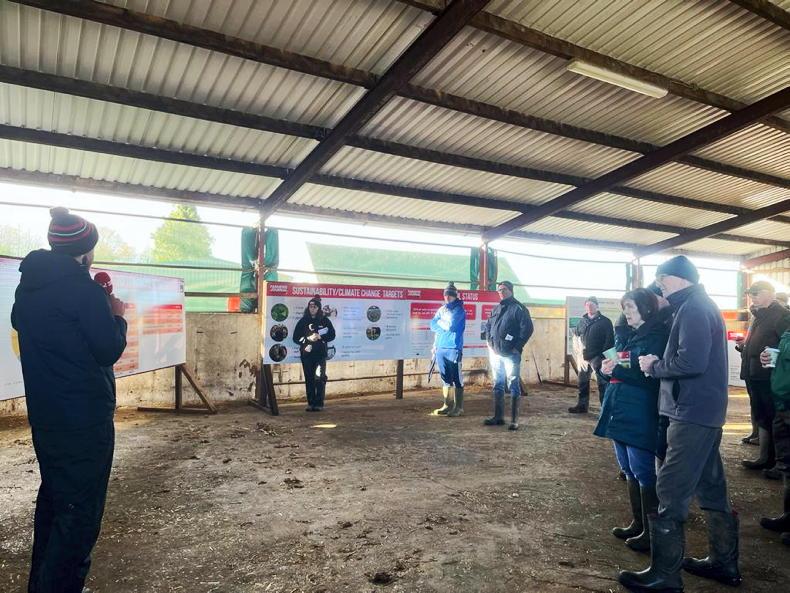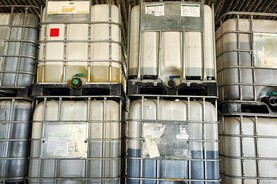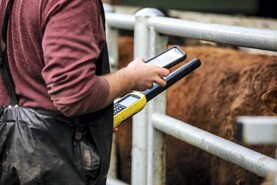Despite a wet morning, skies stayed clear over Tullamore last Thursday for the Footprint Farmers Open Day. A good crowd attended the event and there was plenty of discussion on a range of topics, from feeding red clover silage to ewes, silage and slurry testing, the animal health plan for the winter, the winter feed plan and a breakdown of the financial situation on the farm. There was also a hedge planting demonstration.
The farm walk began just after 11am and first up was an intro by sustainability specialist Siobhán Walsh, as well as an update on the different measures being undertaken on the farm to improve its sustainability.
Clover swards have been in place on the farm since 2017. In addition, there is a 100% two-year-old calving rate and an early slaughter age for young bulls.
There has also been a 15% reduction in nitrogen application, as well as the use of protected urea.
Soil carbon was measured on the farm and a biodiversity plan has also been put in place. Low-emission slurry spreading (LESS) is also in use on the farm.
In terms of silage testing results, the results of the red clover silage sward was of particular interest among those in attendance. The dry matter was 37.2%, which will promote high intakes, as well as a high crude protein value of 16.6%.
Some of the questions posed to farm manager Shaun Diver included his plan for feeding the red clover silage that was made this year. Shaun plans to use the 13 bales to feed twin- and triplet-bearing ewes, which will reduce the use of concentrates.
There was also some discussion surrounding the mineral analysis of the silage, which is important so farmers can pinpoint any deficiencies and plan supplementation accordingly.
There was plenty of interest in the multispecies sward planted on the farm and how it is getting on.
The multispecies sward was sown around 20 May and was first grazed on 12 July.
It was grazed lightly with sheep first. There have been four grazings from it so far. The mix that was planted included red clover, white clover, timothy, two perennial ryegrasses, chicory and plantain.
Questions arising from this section of the walk included concerns surrounding the persistency of the chicory and plantain. However, Shaun stressed the importance of choosing a mix that contains good ryegrasses for this reason.
Tullamore Farm vet Dónal Lynch was also present to discuss the animal health plan for the winter. Concerns surrounding pneumonia and winter housing were expressed by farmers.
While temperatures are cooler this week, they have been higher than what is normal for this time of the year. Donál advised farmers to ensure correct stocking densities in sheds and make sure there is good ventilation throughout. While the sheds on Tullamore Farm are well ventilated, they are built close together.
This is not ideal, Dónal said. However, he explained that nearly all farmyards in Ireland are similar due to space limitations and, therefore, the focus should be put on maintaining a correct stocking density within each shed and vaccinating animals.
Poor ventilation in sheds can result in stale air lingering, which will ultimately increase the spread of viruses and bacteria.
The second half of the event saw farmers move outside to watch a hedge planting demonstration. The hedge being planted on the day was a topped hedge. While a mix of topped and escaped hedges are recommended, there are lots of escaped hedges along the boundary of the farm.
This hedge was put in close to the farmyard. There was a lot of interest in the hedge planting under ACRES, as well as costings.

There was a lot of interest in the hedge planting under ACRES, as well as costings.
Under ACRES, 750m of new hedging can be planted, which receives a payment of €5.29/m/year for five years.
A minimum of 10m must be planted. There must also be five plants per metre in a double staggered row and there must be at least three species planted, with no one species making up more than 70% of the total.
Sustainability specialist Siobhán Walsh also stressed the importance of ensuring that any plants used are of Irish origin or provenance and are bought from registered producers.
In terms of costing, as per Teagasc guidelines, 100m of a new hedge will cost approximately €550, with compostable plastic costing about 50c per metre.
Despite a wet morning, skies stayed clear over Tullamore last Thursday for the Footprint Farmers Open Day. A good crowd attended the event and there was plenty of discussion on a range of topics, from feeding red clover silage to ewes, silage and slurry testing, the animal health plan for the winter, the winter feed plan and a breakdown of the financial situation on the farm. There was also a hedge planting demonstration.
The farm walk began just after 11am and first up was an intro by sustainability specialist Siobhán Walsh, as well as an update on the different measures being undertaken on the farm to improve its sustainability.
Clover swards have been in place on the farm since 2017. In addition, there is a 100% two-year-old calving rate and an early slaughter age for young bulls.
There has also been a 15% reduction in nitrogen application, as well as the use of protected urea.
Soil carbon was measured on the farm and a biodiversity plan has also been put in place. Low-emission slurry spreading (LESS) is also in use on the farm.
In terms of silage testing results, the results of the red clover silage sward was of particular interest among those in attendance. The dry matter was 37.2%, which will promote high intakes, as well as a high crude protein value of 16.6%.
Some of the questions posed to farm manager Shaun Diver included his plan for feeding the red clover silage that was made this year. Shaun plans to use the 13 bales to feed twin- and triplet-bearing ewes, which will reduce the use of concentrates.
There was also some discussion surrounding the mineral analysis of the silage, which is important so farmers can pinpoint any deficiencies and plan supplementation accordingly.
There was plenty of interest in the multispecies sward planted on the farm and how it is getting on.
The multispecies sward was sown around 20 May and was first grazed on 12 July.
It was grazed lightly with sheep first. There have been four grazings from it so far. The mix that was planted included red clover, white clover, timothy, two perennial ryegrasses, chicory and plantain.
Questions arising from this section of the walk included concerns surrounding the persistency of the chicory and plantain. However, Shaun stressed the importance of choosing a mix that contains good ryegrasses for this reason.
Tullamore Farm vet Dónal Lynch was also present to discuss the animal health plan for the winter. Concerns surrounding pneumonia and winter housing were expressed by farmers.
While temperatures are cooler this week, they have been higher than what is normal for this time of the year. Donál advised farmers to ensure correct stocking densities in sheds and make sure there is good ventilation throughout. While the sheds on Tullamore Farm are well ventilated, they are built close together.
This is not ideal, Dónal said. However, he explained that nearly all farmyards in Ireland are similar due to space limitations and, therefore, the focus should be put on maintaining a correct stocking density within each shed and vaccinating animals.
Poor ventilation in sheds can result in stale air lingering, which will ultimately increase the spread of viruses and bacteria.
The second half of the event saw farmers move outside to watch a hedge planting demonstration. The hedge being planted on the day was a topped hedge. While a mix of topped and escaped hedges are recommended, there are lots of escaped hedges along the boundary of the farm.
This hedge was put in close to the farmyard. There was a lot of interest in the hedge planting under ACRES, as well as costings.

There was a lot of interest in the hedge planting under ACRES, as well as costings.
Under ACRES, 750m of new hedging can be planted, which receives a payment of €5.29/m/year for five years.
A minimum of 10m must be planted. There must also be five plants per metre in a double staggered row and there must be at least three species planted, with no one species making up more than 70% of the total.
Sustainability specialist Siobhán Walsh also stressed the importance of ensuring that any plants used are of Irish origin or provenance and are bought from registered producers.
In terms of costing, as per Teagasc guidelines, 100m of a new hedge will cost approximately €550, with compostable plastic costing about 50c per metre.







 This is a subscriber-only article
This is a subscriber-only article










SHARING OPTIONS: